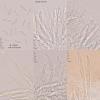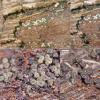
24-03-2024 08:27
 Thierry Blondelle
Thierry Blondelle
HiOn Hedera helix fallen branchEcological habitat:

26-04-2024 10:07
 Mathias Hass
Mathias Hass
Hello, Does anyone know what this is? Found on J

24-04-2024 21:54
Bonjour, J'ai trouvé ce Lasiobolus sur laissées

23-04-2024 15:18
 Lothar Krieglsteiner
Lothar Krieglsteiner
... but likely a basidiomycete. I hope it is o.k.

23-04-2024 13:17
 Edouard Evangelisti
Edouard Evangelisti
Bonjour à tous, Je viens de récolter ce que je

23-04-2024 21:49
Ethan CrensonHello all, A friend recently found this orange as

22-04-2024 11:52
 Zuzana Sochorová (Egertová)
Zuzana Sochorová (Egertová)
Hello,I made a loan of a collection of Microstoma

11-01-2022 16:36
Hi does anyone have a digital copy of Raitviir A (

22-04-2024 20:38
 Miguel Ángel Ribes
Miguel Ángel Ribes
Good afternoon.Does anyone know this anamorph?It g
Nitschkiaceae
Enrique Rubio,
08-04-2018 19:20
These minute (200-300 microns) erumpent, gregarious, globulose blackish ascomata are covered by an ephemerous greenish blue tomentum and they vertically collapsing when dry.The fungus was collected on decorticated wood of Prunus dulcis in central west Spain, a region with a mediterraneous climate.
The asci have not a conspicuous apical apparatus and the ascospores are cylindrical, straight to allantoid, smooth, hyaline or sligthly yellowish.I think it could belong to the genus Nitschkia.
Have you some idea for this collection?
Andrew N. Miller,
09-04-2018 20:16

Re : Nitschkiaceae
This is the same species that was sent to me by Javier Bometon. He can share his photos if he likes. I sequenced this for ITS-LSU. Sequences for this species are not in GenBank as nothing came close. The closest match was Cryptosphaeria. This is not a Coronophorales. If someone would like to identify the species, I would be happy to send them the sequences. I might even send you a shiny US Dollar coin for a correct name... ;o)
Cheers,
Andy
Cheers,
Andy
Enrique Rubio,
09-04-2018 20:39
Re : Nitschkiaceae
Hi Andy
It is strange for a member of Diatrypaceae that the ascomata are not immersed and that they collapse easily.
I, too, join you in your offer.
Thanks!
It is strange for a member of Diatrypaceae that the ascomata are not immersed and that they collapse easily.
I, too, join you in your offer.
Thanks!
Andrew N. Miller,
09-04-2018 20:44

Re : Nitschkiaceae
It is very strange, but other things outside of the Coronophorales are known to collapse easily such as Thaxteriella pezizula: http://www.discoverlife.org/mp/20q?guide=Tubeufiaceae
Someone could win US$2.00 - ha!
Andy
Someone could win US$2.00 - ha!
Andy
Enrique Rubio,
09-04-2018 21:30
Re : Nitschkiaceae
OK. Thanks!
Enrique Rubio,
26-02-2023 12:38
Re : Nitschkiaceae
Does anyone know if this fungus, which is extremely common on Prunus dulcis bark, has been formally described?


